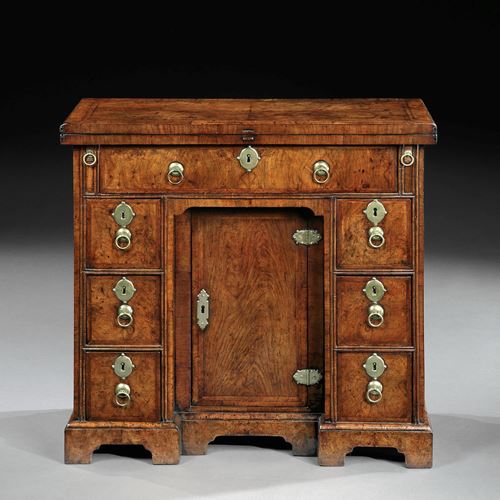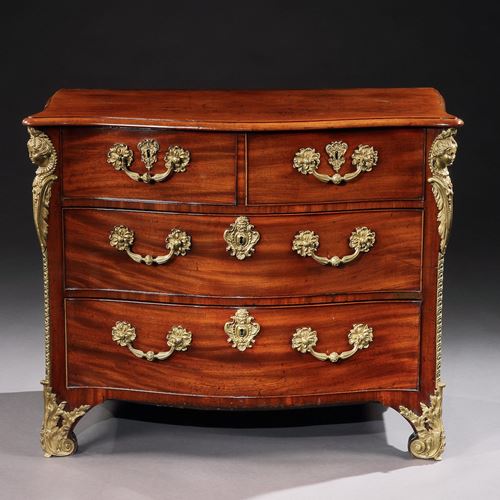search
1/6
CHIPPENDALE: A GEORGE III MAHOGANY BUREAU CABINET
england , circa 1765
SOLD
A magnificent George III Chippendale mahogany bureau cabinet of elegant proportions of superb colour and patina throgughout. With a bold swan-neck pediment carved with scrolling acanthus leaves and a dentil moulded cornice above octagonal glazed doors with moulded glazing bars and cross-banded stiles. With adjustable glass shelves. Above a secretaire drawer opening to reveal a fitted interior of pigeon holes and small drawers and a baize lined wiriting surface. Below with twin doors opening to reveal two short and two long fitted cedar-lined drawers with handles. The secretaire drawer and cupboad doors with astragal shaped moulding and wonderful flame veneers. Standing on moulded bracket feet. With original handles throughout. The hinges stamped H.TIBATS.
A magnificent George III Chippendale mahogany bureau cabinet of elegant proportions of superb colour and patina throgughout. With a bold swan-neck pediment carved with scrolling acanthus leaves and a dentil moulded cornice above octagonal glazed doors with moulded glazing bars and cross-banded stiles. With adjustable glass shelves. Above a secretaire drawer opening to reveal a fitted interior of pigeon holes and small drawers and a baize lined wiriting surface. Below with twin doors opening to reveal two short and two long fitted cedar-lined drawers with handles. The secretaire drawer and cupboad doors with astragal shaped moulding and wonderful flame veneers. Standing on moulded bracket feet. With original handles throughout. The hinges stamped H.TIBATS.
Provenance
With Hotspur Ltd., Belgravia, London
Private Collection, USA
With Mackinnon Fine Furniture, 2014
With Mallett & Son (Antiques) Ltd., London
Private Collection, USA
Private Collection, USA
With Mackinnon Fine Furniture, 2014
With Mallett & Son (Antiques) Ltd., London
Private Collection, USA
Stock number
Q02.37
dimensions
More Details
Literature
Height: 91 in (231 cm)
Width: 40³/₄ in (103.5 cm)
Depth: 22¹/₂ in (57 cm)
Width: 40³/₄ in (103.5 cm)
Depth: 22¹/₂ in (57 cm)
The superb quality of craftsmanship. extraordinary timbers and details of desgn, such as the profile of the cresting and feet, glazing bar pattern, laminated blocks and cut corner doors all correspond to the work of Thomas Chippendale. In particular close comparison can be made to a lady's cabinet supplied for Nostell Priory in 1766 and a pair of bookcases for Wilton House (1760-62), illustrated in C. Gilbert, The Life and Work of Thomas Chippendale, New York, 1978, vol. II, pp. 44-48, 58, figs. 68-70, 90.
This bureau cabinet relates closely in design and construction to a number of examples from the 1754 1st Edition of Thomas Chippendale's Gentleman and Cabinet-Maker's Director. In particular the upswept arched pediment with inwardly carved scroll detail, and the characteristic truss-scrolled feet, which both feature on plate 78 for one of his Desk and Bookcase patterns. Thomas Chippendale only identifies three patrons is his prefatory notes in his Director - the Earls of Morton and Dumfries, and Lord Pembroke. We know that Chippendale received commissions for the extensive furnishings of Dumfries House between the late 1750s and 1760s, supplying some of his finest pieces of furniture from his early rococo phase, including a very similar breakfront bookcase of larger scale.
Lord Pembroke, having inherited Wilton House near Salisbury and Pembroke House in London, employed the architect William Chambers in 1760 for 'Various Designs for Fitting up Rooms'. Invoices verify that Chippendale provided number pieces for the new interiors, often having to consult with Chambers to make the sure the pieces were congruent. An illustration by Chippendale (see photographs) forming part of Chambers' architectural plan for Pembroke House, portrays a large scroll-crested bookcase in elevation, which corrsponds closely to a pair now at Wilton, likely sent there after the demolition of Pembroke House in 1913. Again, although larger in scale, there a clear similarities in the crestings, astragals and panel work.
This bureau cabinet relates closely in design and construction to a number of examples from the 1754 1st Edition of Thomas Chippendale's Gentleman and Cabinet-Maker's Director. In particular the upswept arched pediment with inwardly carved scroll detail, and the characteristic truss-scrolled feet, which both feature on plate 78 for one of his Desk and Bookcase patterns. Thomas Chippendale only identifies three patrons is his prefatory notes in his Director - the Earls of Morton and Dumfries, and Lord Pembroke. We know that Chippendale received commissions for the extensive furnishings of Dumfries House between the late 1750s and 1760s, supplying some of his finest pieces of furniture from his early rococo phase, including a very similar breakfront bookcase of larger scale.
Lord Pembroke, having inherited Wilton House near Salisbury and Pembroke House in London, employed the architect William Chambers in 1760 for 'Various Designs for Fitting up Rooms'. Invoices verify that Chippendale provided number pieces for the new interiors, often having to consult with Chambers to make the sure the pieces were congruent. An illustration by Chippendale (see photographs) forming part of Chambers' architectural plan for Pembroke House, portrays a large scroll-crested bookcase in elevation, which corrsponds closely to a pair now at Wilton, likely sent there after the demolition of Pembroke House in 1913. Again, although larger in scale, there a clear similarities in the crestings, astragals and panel work.
C. Gilbert, The Life and Work of Thomas Chippendale, New York, 1978, vol. II, pp. 44-48, 58, figs. 68-70, 90.
Mallett Catalogue, 2015, pp. 35 - 37
Mallett Catalogue, 2015, pp. 35 - 37


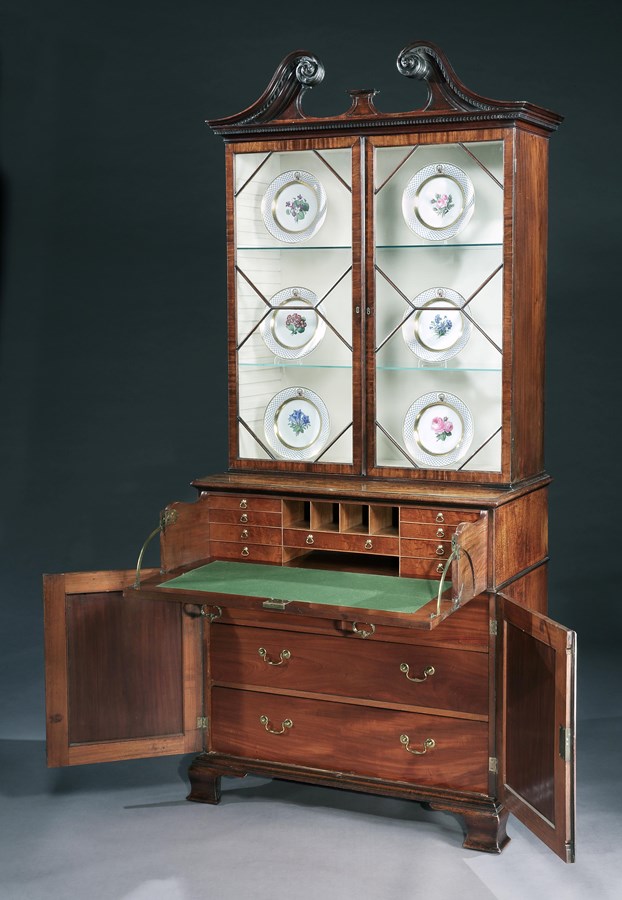
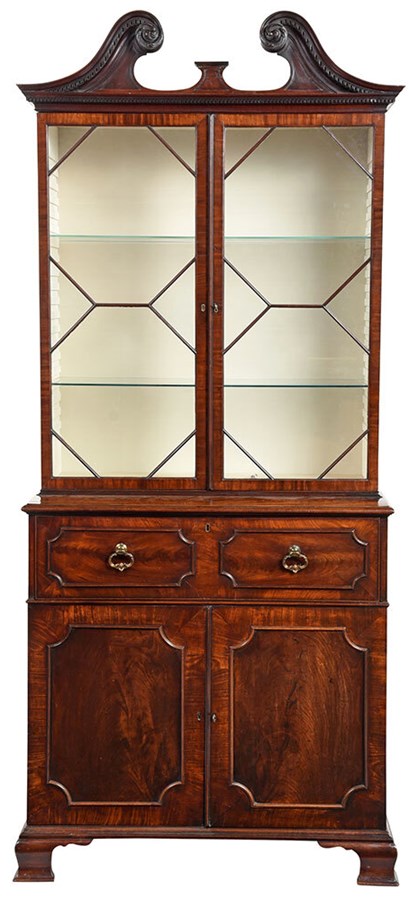
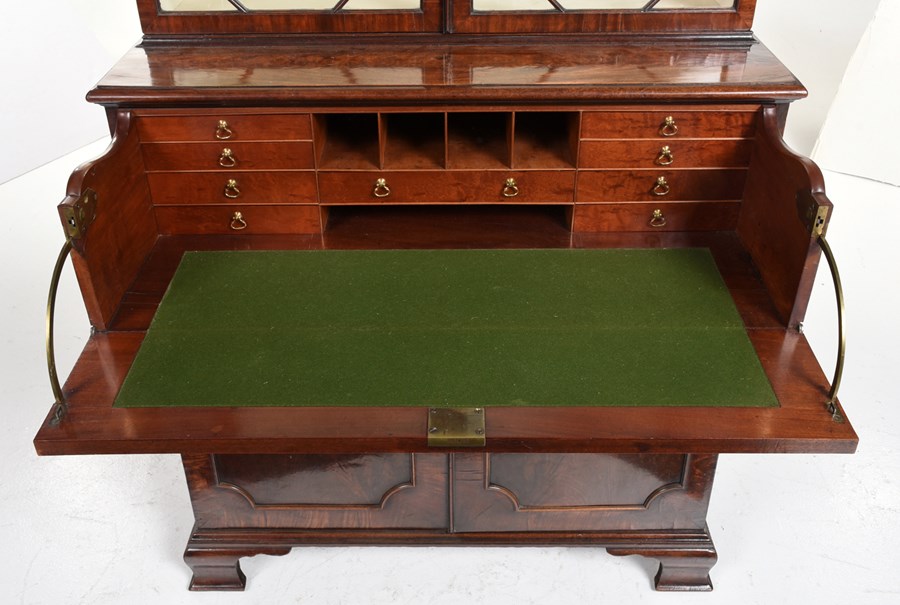
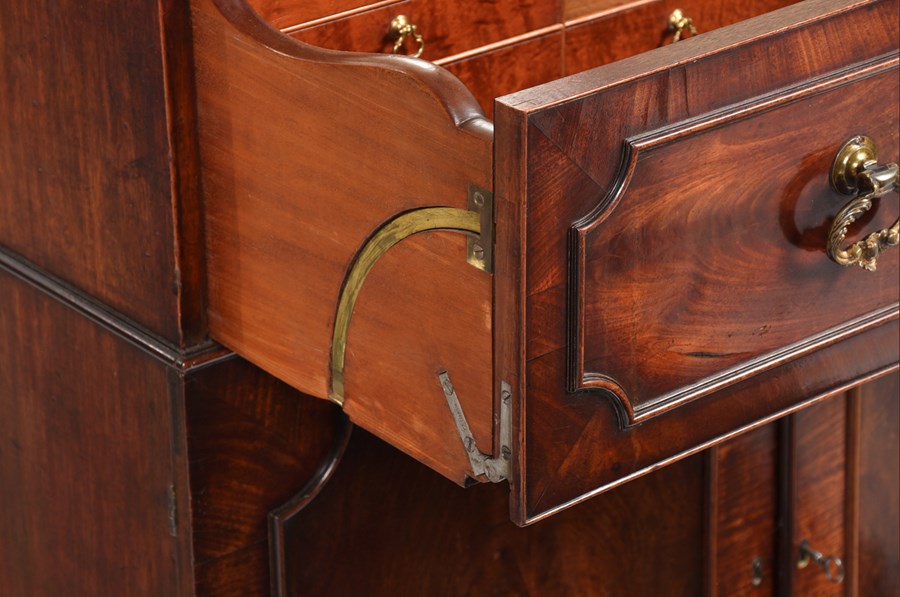
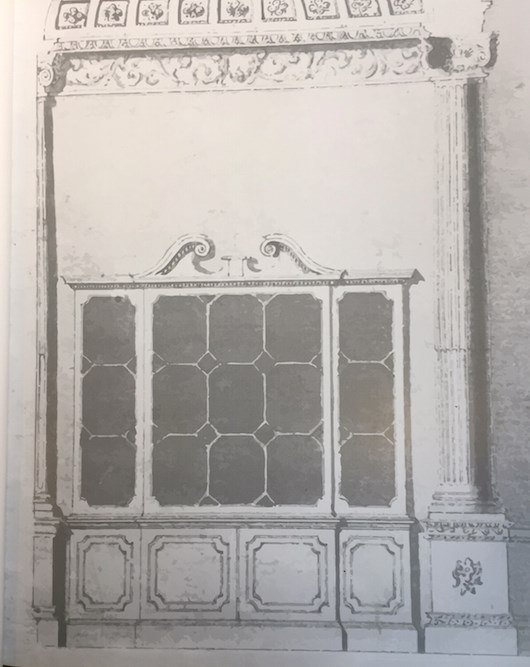


 enquire
enquire
 +44 (0)20 7839 5671
+44 (0)20 7839 5671
 +44 (0)7725 332 665
+44 (0)7725 332 665

